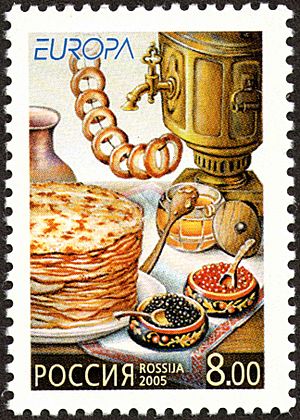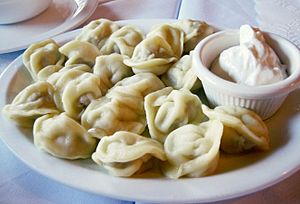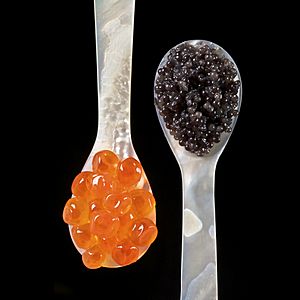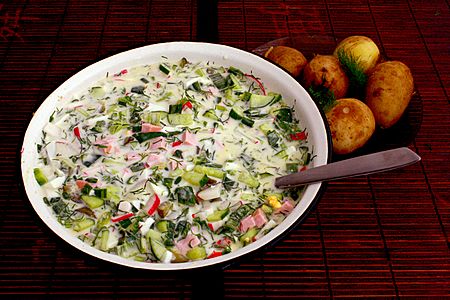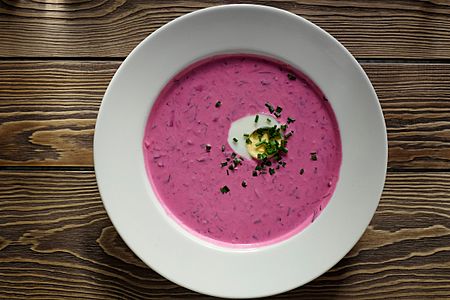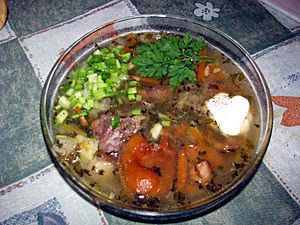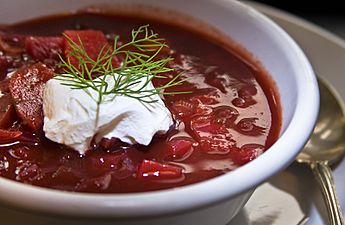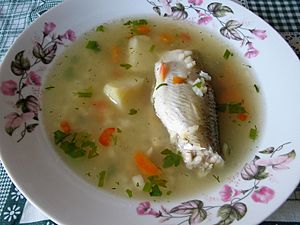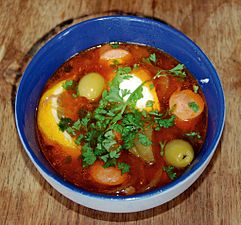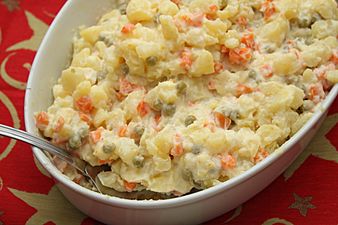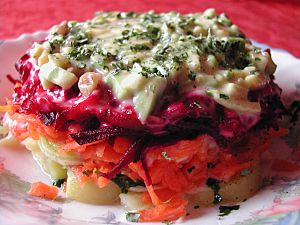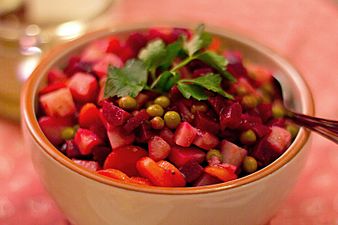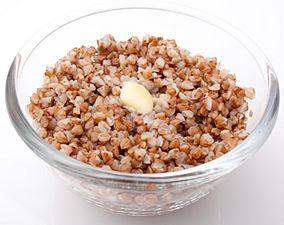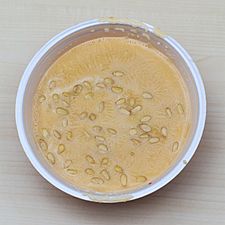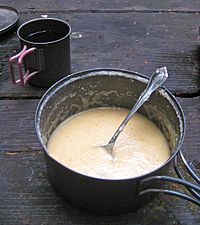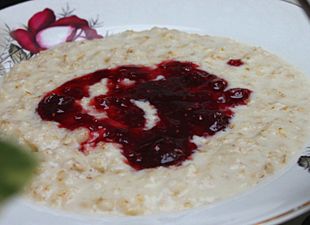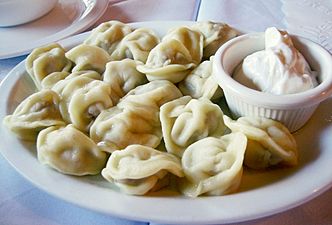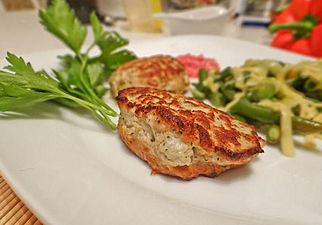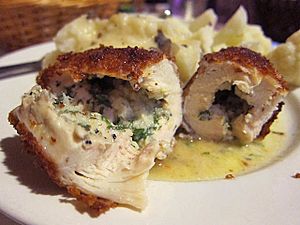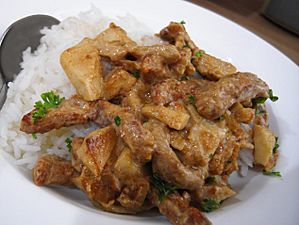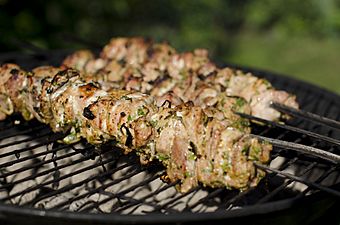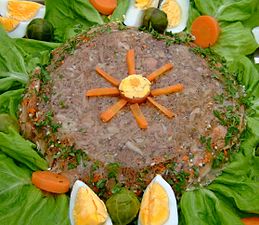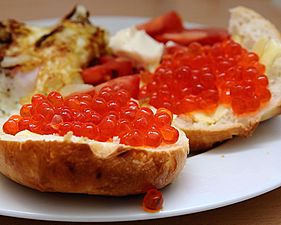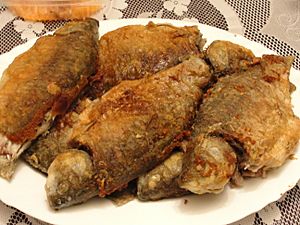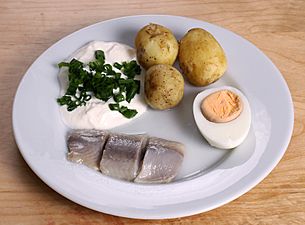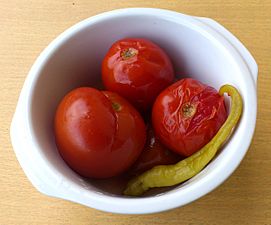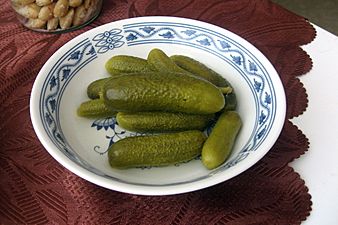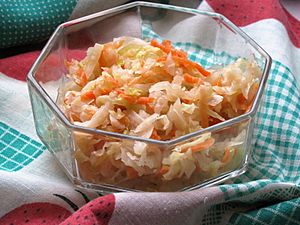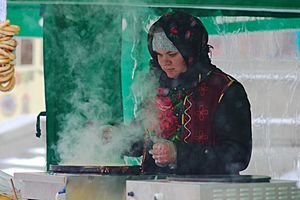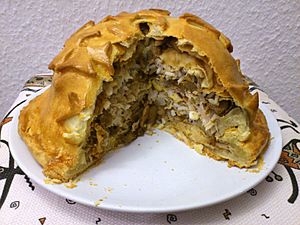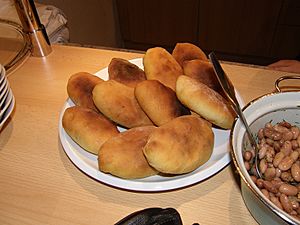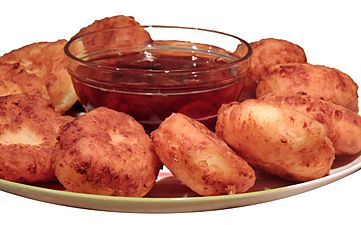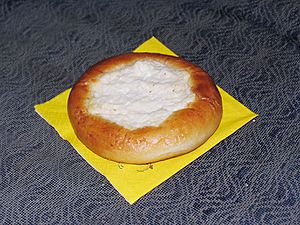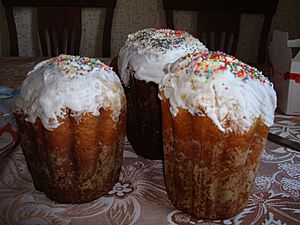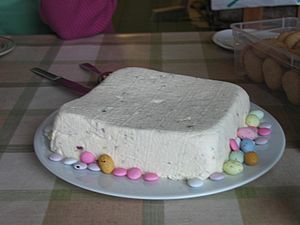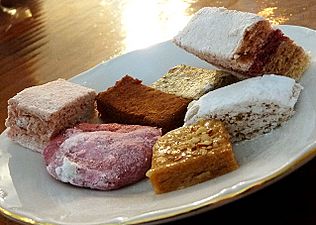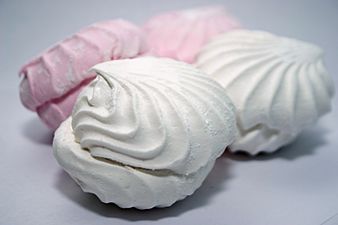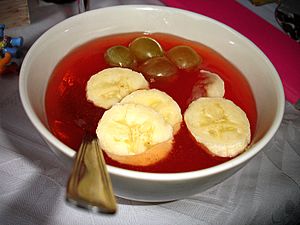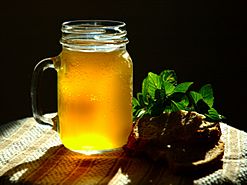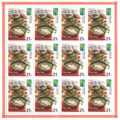Russian cuisine facts for kids
Russian cuisine is all about the different dishes and cooking styles of the Russian people. It includes many popular foods that have been around for a long time, from various parts of society.
Contents
History of Russian Food
The history of Russian food can be split into four main periods. The first was Old Russian cuisine (from the 9th to 16th centuries). During this time, people ate a lot of bread, grains, and starchy foods. Women baked pies with fillings like mushrooms or berries. Bread and salt were always important at gatherings. Foods like kasha (porridge made from grains like buckwheat or oats) were seen as a sign of a healthy home. Russians also used honey and berries to make gingerbread, which is still a popular dessert today. Many Russian dishes, like pelmeni, were inspired by Asian cultures.
In the 17th century, food became different for rich and poor people. The wealthy ate meat and special foods like caviar, while the poor had simpler meals. More foods appeared as Russia grew and added new lands.
During the time of Peter the Great and Catherine the Great (18th century), minced meat became popular in dishes. Russian food also started mixing with cuisines from other European countries. In the last period, called Petersburg Cuisine (late 18th century to 1860s), many French, German, Dutch, and Italian meals, like lamb and pork, were added to Russian cooking. The French helped make potatoes and tomatoes popular. Because Russia has long, cold winters, many dishes were made to last a long time, so people didn't have to go out often for food.
Russian cuisine started with simple peasant food, made in a tough climate. People ate a lot of fish, pork, chicken, caviar, mushrooms, berries, and honey. Grains like rye, wheat, barley, and millet were used to make many kinds of breads, pancakes, pies, cereals, beer, and vodka. Soups and stews were made with seasonal foods, fish, and meats. These simple foods were what most Russians ate until the 20th century.
From the 16th to 18th centuries, cooking methods became more advanced. Smoked meats and fish, pastries, salads, green vegetables, chocolate, ice cream, wines, and juices came from other countries. Rich families started mixing these new foods with traditional Russian dishes.
In the early 20th century, after the Russian Revolution, fancy cooking became less common. This was because of new ideas about equality and because the old rich families, who enjoyed these foods, were no longer around. This led to the creation of Soviet cuisine, which focused on mixing foods from different parts of the Soviet Union, using scientific ideas about diet, and making food in factories.
When the Soviet Union ended, people could get all kinds of food again. As people became more prosperous, they wanted new food experiences. This brought back some of the fancy foods from the Imperial era and also led to new, creative Russian dishes.
Regional Food Differences
Russian cuisine has grown in a country with many different cultures and ethnic groups. This means that Russian food has been greatly influenced by the foods of other groups living in Russia or who were historically part of the Russian state.
Even with all this mixing, many local foods within Russia are still unique. For example, there are separate cuisines like Tatar, Sakha, or Yamal food.
Russian cuisine also changes depending on the region. In the North of Russia, people use local berries like cloudberry or crowberry, fish like cod, and game meat like elk. They even eat edible moss called yagel. In Siberia, local fish like arctic cisco are popular. People there also use local cooking methods, like eating raw fish frozen (stroganina) or mixed with spices (sugudai). Further East, special foods like eagle fern, kolomikta fruit, scallops, and Kamchatka crabs are added to dishes.
Soups
Soups have always been very important in Russian cooking. Traditional soups like shchi (cabbage soup), borscht, ukha (fish soup), rassolnik, solyanka, botvinya, okroshka, and tyurya have been around for a long time. From the 18th to 20th centuries, new types of soups from Europe and Central Asia, like clear soups and pureed soups, also became popular.
Russian soups can be put into at least seven main groups:
- Cold soups made with kvass, like tyurya, okroshka, and botvinya.
- Light soups with water and vegetables, like svekolnik.
- Noodle soups with meat, mushrooms, or milk.
- Soups made with cabbage, especially shchi.
- Thick soups with meat broth and a salty-sour taste, like rassolnik and solyanka.
- Fish soups, such as ukha.
- Soups made with grains and vegetables.
Cold Soups
Okroshka is a cold soup made with kvass (a fermented drink) or sour milk, like kefir. It's also a type of salad. The main ingredients are two kinds of vegetables, which can be mixed with cold cooked meat or fish. So, there are vegetable, meat, chicken, and fish versions of okroshka.
Usually, okroshka has two types of vegetables. The first kind has a mild taste, like boiled potatoes, carrots, or fresh cucumbers. The second kind is spicy and flavorful, like radishes or green onions, and other herbs like dill or parsley. Different meats can be used, often beef alone or with chicken. Sometimes, a mild sausage is used. If made with fish, mild-tasting fish like cod are best. In coastal areas, smoked or salted salmon is often used, sometimes with other meats.
The kvass used for cooking okroshka is usually white and more sour than drinking kvass. Spices like mustard, black pepper, and pickle juice are added. For the final touch, boiled eggs and smetana (like sour cream) are mixed in. Often, mustard, chopped egg yolks, pepper, and pickle juice are combined into a spicy sauce to add to the soup.
For okroshka made with sour milk, well-shaken natural sour milk (sometimes with oil) is used, mixed with water and crushed garlic. Sometimes, store-bought kefir is used to save time, though some people say it changes the original taste.
Tyurya is very similar to okroshka. The main difference is that instead of vegetables, bread (sometimes with onion and oil) is soaked in kvass. This was a common food during tough times, like wars, and for poor farmers. Because it was so simple, it was also a popular meal during religious fasting.
Botvinya is another cold soup. Its name comes from the Russian word botva, meaning "leafy tops of root vegetables." True to its name, it's made with the leafy tops of young beets, as well as sorrel, scallions, dill, cucumbers, and two types of kvass. Mustard, garlic, and horseradish are added for flavor. The vegetables are cooked briefly, then strained, and kvass is poured over them.
Svyokolnik (also called kholodnik) is a cold borscht. It's made from beet sour or beet juice mixed with sour cream, buttermilk, sour milk, kefir, or yogurt. This mixture has a special orange or pink color. It's served cold, usually with finely chopped beetroot, cucumbers, radishes, and spring onions. Halved hard-boiled eggs and fresh dill are sprinkled on top. Sometimes, chopped veal, ham, or crawfish tails are added.
Hot Soups
Shchi (cabbage soup) has been the most important first course in Russian cooking for over a thousand years. Shchi was eaten by everyone, rich or poor. Even if the rich used more expensive ingredients and the poor only used cabbage and onions, all versions were cooked in the same way. The special taste of this cabbage soup came from letting it stew in a Russian stove after cooking. Many Russian sayings are about shchi, like "Shchi and porridge are our main foods." It can be eaten regularly, any time of year.
A richer shchi has several ingredients, but two are always a must:
- Cabbage.
- Meat (sometimes fish or mushrooms).
- Carrots, basil, or parsley roots.
- Flavorful herbs (onions, celery, dill, garlic, pepper, bay leaf).
- Sour ingredients (smetana, apples, sauerkraut, pickle water).
When shchi is served, smetana is added. It's eaten with rye bread. In the past, shchi was sometimes thickened with flour mixed with boiling broth to make it more filling, especially if there was no meat. But by the late 18th century, especially in fancy cooking, this was stopped for a better taste. For much of the year, when the Orthodox Christian Church asks people to avoid meat and dairy, a vegan version of shchi is made. "Kislye" (sour) shchi are made from pickled cabbage (sauerkraut). "Serye" (grey) shchi are made from the green outer leaves of the cabbage. "Zelyonye" (green) shchi are made from sorrel leaves, not cabbage, and used to be a popular summer soup.
Borscht is made with broth, beets, and tomatoes, plus other vegetables like onions, cabbage, carrots, and celery. Borscht usually has meat, often beef in Russia and pork in Ukraine. It's usually served very hot, with sour cream, chopped chives or parsley, and crushed garlic. Borscht is traditionally eaten with black bread. Borscht is also a national dish in other Eastern European countries like Ukraine, Poland, Belarus, and Lithuania.
Ukha is a warm, watery fish dish. It's not exactly a fish soup. The name "ukha" for fish broth became common only in the late 17th to early 18th centuries. Before that, the name was used for thick meat broths, and later for chicken broths. From the 15th century, fish was used more and more to make ukha, creating a unique dish among soups.
Very few vegetables are added when making ukha. In traditional cooking, ukha was simply a rich fish broth served with fish pies. Today, it's more often a fish soup cooked with potatoes and other vegetables. Many types of freshwater fish are traditionally used.
Rassolnik is a hot soup with a salty-sour cucumber base. This dish became common in Russian cuisine quite late, only in the 19th century. Around this time, it got the name rassolnik, from the Russian word rassol, meaning "brine" (pickle water). Pickle water had been used as a soup base since at least the 15th century. Its amount and mix with other liquids and soup parts led to different soups: solyanka, shchi, and rassolnik. Rassolnik is a moderately sour-salty soup based on pickled cucumbers. Some versions are vegetarian, but more often they include veal or beef kidneys, or chicken giblets (stomach, liver, heart, neck, feet). For the best taste, there needs to be a balance between the sour part and neutral ingredients like cereals, potatoes, or root vegetables. Typical rassolnik uses kidneys, brine (and pickles), vegetables, and barley.
Kal'ya was a very common dish in the 16th–17th centuries, but it almost disappeared from Russian cuisine. It was often wrongly called "fish rassolnik." The cooking method is mostly the same as ukha, but pickled cucumbers, pickle water, lemons, and lemon juice were added to the broth. The main thing about kal'ya is that only fatty, rich fish was used; sometimes caviar was added. More spices are added, making the soup spicier and thicker than ukha. Kal'ya used to be a special holiday dish.
Solyanka is a thick, spicy soup that combines parts of shchi (cabbage, smetana) and rassolnik (pickle water and cucumbers). Spices like olives, capers, tomatoes, lemons, lemon juice, kvass, and salted or pickled mushrooms create a very strong sour-salty base for the soup. Solyanka is much thicker than other soups, with about one-third less liquid. There are three types: meat, fish, and simple solyanka. The first two are made with strong meat or fish broths, and the last with mushroom or vegetable broth. All broths are mixed with cucumber pickle water.
Lapsha (noodle soup) was adopted by Russians from Tatars and became very popular in Russia after some changes. It comes in three types: chicken, mushroom, and milk. All three are simple to make: prepare the noodles, cook the broth, and boil the noodles in the broth. Noodles are made from wheat flour or a mix of buckwheat and wheat flour. Mixed flour noodles go better with mushroom or milk broth.
Salads
Olivier salad (also called Russian salad) is a potato salad with mayonnaise. It's known for its small diced pieces and the mix of flavors from pickles, hard-boiled eggs, boiled carrots, boiled potatoes, meat, and peas. This dish is a main part of New Year's celebrations.
Sel'edka pod shuboy (or shuba, meaning "fur coat") is chopped salted herring under layers of cooked shredded beet, sometimes with egg or other vegetables.
Vinegret is a salad made of boiled beets, potatoes, carrots, pickles, onions, sauerkraut, and sometimes peas or white beans. It's dressed with sunflower or olive oil.
Porridge
Porridge is one of the most important dishes in traditional Russian cuisine. The types of grains used depend on what grows locally. In Russian, the word kasha means any kind of porridge.
The most popular grains are buckwheat, millet, semolina, oats, barley, and rice. Traditionally, porridge is cooked in milk, especially for breakfast. Butter, salt, sugar, jams, fresh fruit, and berries can be added.
Plain cooked porridges, especially buckwheat and rice, can be served as a side dish with other meals.
Main Dishes
Meat Dishes
In traditional Russian cooking, there are three main types of meat dishes:
- A large piece of meat boiled in a soup or porridge, then served as a second course or cold (especially in jellied stock like kholodets).
- Dishes made from organ meats (like liver), baked in pots with grains.
- Whole birds or parts of birds (legs or breasts), or a large piece of meat (like a rump roast) baked in an oven. This is called "zharkoye" (from "zhar," meaning "heat").
In wealthy homes, people also made sausages, spit-roasted meats, stews, and many other meat dishes.
In the past, meat dishes were often served with porridges and cereals, or with boiled and baked root vegetables (turnips, carrots) and mushrooms. Meat was also served with pickled foods like pickled cabbage, or sour and marinated apples or cranberries. Juices from the pan, sometimes mixed with sour cream or melted butter, were used as gravy for vegetables and porridges. Meat sauces made with flour, butter, eggs, and milk are not common in traditional Russian cooking.
Pelmeni are a traditional Eastern European dish, mostly Russian. They are made with minced meat filling wrapped in thin dough (flour and eggs, sometimes with milk or water). For the filling, pork, lamb, beef, or a mix of meats can be used. A traditional Ural recipe uses 45% beef, 35% lamb, and 20% pork. Spices like pepper, onions, and garlic are usually mixed into the filling.
Russians likely learned to make pelmeni from Finno-Ugric people. The word means "ear-shaped bread" in Finno-Ugric languages. In Siberia, pelmeni were made in large amounts and stored frozen outside for months during winter. In mainland Russia, "Siberian pel'meni" means pelmeni made with a mix of meats. By the late 19th century, they were a common food in Russian cities. They are cooked by boiling them in water until they float, then for 2–5 more minutes. They are served with butter or sour cream (mustard, horseradish, and vinegar are also popular). Some recipes suggest frying pelmeni after boiling until they are golden brown.
Pelmeni are a type of dumpling. They are similar to vareniki, a Ukrainian dumpling with fillings like mashed potatoes, cheese, or cherries. They also resemble Chinese potstickers, Tibetan mo-mo, Italian ravioli, and Central Asian manti. The main difference is their shape and size; a typical pelmen' is round and about 2 to 3 cm wide, while most other dumplings are longer and larger.
Making pelmeni by hand takes a lot of effort, but a pelmennitsa makes it much faster. This tool is usually a round aluminum plate with many holes surrounded by raised edges. A sheet of dough is placed over the holes, filling is put into each "cell," and the dough sags to form the dumpling. Another sheet of dough is placed on top, and a wooden roller is rolled over it. This presses the dough layers together, cuts the dumplings apart by the edges, and makes them fall through the holes. Using a pelmennitsa, a cook can quickly make many dumplings at once.
Many minced meat dishes were adopted from other cuisines and became popular only in the 19th and 20th centuries; they are not typical of traditional Russian cuisine.
Kotlety (minced cutlets) are pan-fried patties, similar to Salisbury steak. Kotlety are made from pork and beef, or from chicken, and sometimes from fish. In common recipes, ground meat, pork, onions, and bread are mixed well. Then, patties are shaped and cooked in a hot frying pan. The Pozharsky cutlet is a fancier version that was adopted by French fine dining.
Beef Stroganoff: Sautéed pieces of beef served in a sauce with smetana (sour cream). It started in Russia in the mid-19th century and is now popular worldwide, with many different versions.
Shashlyk is a type of shish kebab (marinated meat grilled on a skewer) popular in former Soviet Union countries like Georgia, Russia, Armenia, Azerbaijan, and Uzbekistan. It often has alternating slices of meat and onions. Although the word "shashlyk" came from the Crimean Tatars to the Cossacks as early as the 18th century, kebabs didn't reach Moscow until the late 19th century. After that, their popularity grew quickly. By the 1910s, they were common in St. Petersburg restaurants, and by the 1920s, they were a common street food all over urban Russia. Shashlyk is also used in Russia for outdoor cooking, similar to barbecue in English-speaking countries.
Kholodets (or studen): Jellied chopped pieces of pork or veal with spices (pepper, parsley, garlic, bay leaf) and small amounts of vegetables (carrots, onions). The meat is boiled in large pieces for a long time, then chopped, boiled a few more times, and finally chilled for 3–4 hours (which is why it's called kholodets, meaning "cold"). This forms a jelly mass. Gelatin is not used because parts like calves' feet and pigs' heads naturally have enough gelatin. It is served with horseradish, mustard, or ground garlic with smetana.
Fish Dishes
Fish was very important in Russian cooking before the Revolution. This was especially true on Russian Orthodox fast days when meat was not allowed, similar to the Catholic custom of eating fish instead of meat on Fridays. Freshwater fish like carp and zander were commonly eaten in inland areas. Sturgeon, salmon, pike, and trout were also popular in northern areas. Many other types of fish, including saltwater fish, were preserved by salting, pickling, or smoking. These were eaten as "zakuski" (appetizers).
Selyodka pod shuboi
There is a modern Russian dish called selyodka pod shuboi, which means "fur-coated herring." It's like a mix of "svekolnik" and pickled herring. Pickled herring is covered with layers of potatoes, mayonnaise or smetana (sour cream), and grated beet on top (which looks like a "fur coat").
Vegetables
Cabbage, potatoes, and greens that can handle cold weather are common in Russian and other Eastern European foods. Pickling cabbage (sauerkraut), cucumbers, tomatoes, and other vegetables in salty water is used to save them for winter. Pickled apples and some other fruits were also very popular. These pickled foods provide vitamins when fresh fruits and vegetables are not available.
Desserts and Pastries
The first type of honey bread was made with just rye flour, honey, and berry juice. It came to Russia from Egypt in the 9th century. Later versions from the 12th and 13th centuries included spices bought in markets from India and the Middle East. Tula gingerbread has been known since 1685. Historically, famous bakers made it using gingerbread molds carved by hand from local birch and pear trees.
Pirozhki (singular: pirozhok) are small stuffed buns or pies made from yeast dough or short pastry. They are filled with many different things and are either baked (an old Slavic way) or shallow-fried (a method borrowed from the Tatars in the 13th century). One thing that makes pirozhki different from, say, English pies, is that the fillings are almost always fully cooked. Using chopped hard-boiled eggs in fillings is another interesting feature. Six common fillings for traditional pirozhki are:
- Chopped boiled meat mixed with cooked onions.
- Rice and boiled eggs with dill.
- Fish cooked with onions and mixed with hard-boiled chopped eggs and rice.
- Mashed potatoes mixed with dill and green onion.
- Cooked cabbage.
- Cooked mushrooms with onions and sometimes carrots.
Polish pierogi (a type of dumpling) are not really related to Russian "pirogi" (pies) and "pirozhki" (small buns or pies).
Blin are thin pancakes, similar to crepes. They are traditionally made with buckwheat flour and a yeasted batter, though non-yeasted batter is now common. They can be topped or filled with butter, smetana (sour cream), fruit preserves, or caviar. Blini are often served during Maslenitsa (Butter Week or Pancake Week), a spring festival before Lent, but they are also a common breakfast food. The word "blin" comes from an Old Slavic word meaning "to mill."
Blin had a special meaning for early Slavic people before Christianity. They were a symbol of the sun because of their round shape. They were traditionally made at the end of winter to celebrate the return of the new sun during Maslenitsa. This tradition was adopted by the Orthodox Church and continues today, as the last week of dairy and egg products before Lent. Bliny are still often served at wakes, to remember someone who has passed away. Blini can be made from wheat, buckwheat, or other grains, but wheat blini are most popular in Russia. The word "blin" is also sometimes used as a mild curse word to show frustration.
Syrniki are fried curd fritters. They are served with sour cream, jam, honey, or applesauce.
Vatrushka is a type of cake with a ring of dough and tvorog (cottage cheese) in the middle. It often has raisins or fruit pieces and can be from about five inches to two and a half feet wide.
Kulich is a type of Easter bread that is traditional in the Orthodox Christian faith. It is eaten in countries like Russia, Belarus, Ukraine, and others.
Traditionally, after the Easter church service, the kulich is put in a basket, decorated with colorful flowers, and blessed by a priest. Blessed kulich is eaten before breakfast each day. Any leftover kulich that wasn't blessed is eaten with Paskha for dessert.
Kulich is baked in tall, round tins (like coffee or juice cans). Once cooled, it's decorated with white icing that drips down the sides and colorful flowers. Historically, it was often served with cheese paska that had the letters XB on it (from the Easter greeting "Christ is Risen").
Kulich is only eaten between Easter and Pentecost. The recipe for kulich is similar to the Italian panettone.
Paskha is a special holiday dish made in Eastern Orthodox countries. It's made from foods that are not allowed during the fasting period of Great Lent. It's prepared during Holy Week and then brought to church on Great Saturday to be blessed after the Easter Vigil. The dish's name comes from Pascha, the Eastern Orthodox celebration of Easter.
Cheese paskha is a traditional Easter dish made from quark (curd cheese, tvorog). It is white, symbolizing the purity of Christ and the joy of the Resurrection. It's shaped in a mold, usually like a pyramid with the top cut off (a symbol of the Church, and also said to represent the Tomb of Christ). It's usually served with a rich Easter bread called paska (in Ukrainian) or kulich (in Russian).
The paskha is decorated with religious symbols, like the "Chi Ro" sign, a three-bar cross, and the letters X and B (Cyrillic letters for "Christ is Risen!"). All these decorations symbolize Christ's suffering and Resurrection.
Varenye is a dessert and condiment. It's made by cooking fruits or berries. It's similar to jam, but the fruits stay whole, and the consistency is more like fruit in syrup. It's used as a topping for crepes and syrniki, and as a sweetener for tea. It's also eaten on its own as a sweet treat.
Pastila is a fruit candy. It has been described as "small squares of pressed fruit paste" and "light, airy puffs with a delicate apple flavor." In Imperial Russia, these "small jellied sweetmeats" were served with tea. They had a white foamy top, a bit like marshmallow, but tasted purely of fruit. In its modern form, it's basically fruit meringue, but baked to be soft, not crispy. Unlike its related candy, zefir, real pastila doesn't use gelling agents and has much less egg white.
Zefir (also spelled zephyr) is a soft candy made by whipping fruit and berry puree (mostly apple puree) with sugar and egg whites. Then, a gelling agent like pectin, carrageenan, agar, or gelatin is added. It is commonly made and sold in countries that were part of the former Soviet Union. The name comes from the Greek god of the light west wind, Zephyr, symbolizing its delicate, airy texture.
Zefir is somewhat similar to marshmallows or chocolate-coated marshmallow treats. It comes from the traditional Russian pastila but has added egg white foam and a gelling agent. Its shape usually looks like a traditional meringue. However, unlike store-bought meringue, it is never crispy. It is usually white or pink.
Chocolate-covered versions are also common. Unlike other chocolate-covered marshmallow-like candies, they usually don't have a biscuit layer.
Kissel or kisel is a thick fruit dish, popular as a dessert and a drink. It's made from the sweetened juice of berries, like mors, but it's thickened with cornstarch, potato starch, or arrowroot. Sometimes red wine or fresh or dried fruits are added. It's similar to Danish rødgrød and German Rote Grütze. Swedish blåbärssoppa is a similar bilberry dessert, but only fresh or frozen bilberries are used.
Kissel can be served hot or cold, sometimes with sweetened quark (curd cheese) or semolina pudding. Kissel can also be served on pancakes or with ice cream. If the kissel is made with less thickening starch, it can be drunk—this is common in Russia and Ukraine.
Beverages
Many traditional Russian drinks are unique to Russia and not found in other national cuisines. The most famous are vodka, sbiten', kvass, medovukha, and mors. Many of these are not as common today and have been replaced by drinks from Europe. However, these drinks used to be served with meat and chicken dishes, sweet porridge, and desserts. Sbiten, a very popular medieval drink, is especially notable, but it has since been replaced by tea as Russia's main drink.
Non-alcoholic Drinks
Most non-alcoholic Russian drinks are made from fruits and berries. These include kompot, made by boiling fruit with sweetened water; uzvar, which uses dried fruit instead; mors, made from berries like lingonberry, cranberry, blueberries, or raspberries; and kisel, a thick fruit drink made with cornstarch, potato starch, or arrowroot.
Kvass is an old and still very popular drink made from bread. The basic way to make kvass involves water, flour, and liquid malt. These ingredients are used to make a dough that ferments. This creates a drink with very little alcohol. Store-bought kvass usually has about 0.5% alcohol. The fermented liquid is mixed with water, yeast, sugar, and flavorful additions. This mixture then brews for several days. Flavors can include fruit and berry juices (cherry, raspberry, lemon, etc.), as well as ginger and mint.
Sbiten, another non-alcoholic drink, is made from honey, water, fruit juices, and spices. Sbiten was once the most popular non-alcoholic drink in the country. However, in the last few centuries, tea and coffee have largely replaced it.
Tea is by far the most common drink in almost all parts of Russia. It was first brought from China in the 17th century, and its popularity has spread across the country since then. Black tea has always been the most popular type. But after Russia gained control of Central Asia, people slowly became more aware of and interested in green tea. Today, Russia is still one of the biggest tea consumers in the world. Russian Caravan is perhaps the most well-known type of Russian tea globally.
Until the split between China and the Soviet Union, most tea came from China. Now, Russia imports most of its tea from India and Sri Lanka, with Darjeeling being the most valued kind. Some tea is grown in the southern regions of Russia (mostly in Krasnodar Krai), but the local supply is very small compared to how much the country drinks.
Coffee is also popular but has never become as popular as tea. Peter the Great is credited with bringing coffee to Russia, and the drink has become more common since then. Coffee is usually made using either the Turkish or common European methods.
Images for kids
See also
 In Spanish: Gastronomía de Rusia para niños
In Spanish: Gastronomía de Rusia para niños


